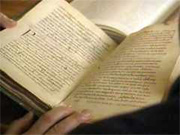- 476 AD | The Fall of Rome
- The Byzantine Empire's Church split from the Roman Catholics in Western Europe
- The East becomes Eastern Catholics
- The Roman Catholics are led by the Pope
- The Eastern Orthodox church looks to the Patriarch in Greece ( previously Patriarch of Constantinople )
- All sects other than Catholics are people who protested the Catholics before
- Led by the Patriarch of Greece ( formerly Constantinople of the Byzantine Empire )
- The Slavs
- Settled in the South of modern Russia
- Had some trade with Constantinople
- The Orthodox Church was worried about the Slavs, so they send a Saint
- Saint Cyril was sent to the Slavs, but they cannot read Greek
- The Slavs' language was not written originally so Saint Cyril had to create a new language
- Vladimir
- He sends emissaries to Rome, the Muslim Faith, and Constantinople
- Rome was terrible at the time so it does not become Catholic
- He does not the Islamic Faith so he does not want it
- Constantinople was the most beautiful city and therefore Vladimir chose Orthodoxy for his people
Last updated 2009-08-14
Christians believe that there is only one God, whom they call Father as Jesus Christ taught them. They recognise Jesus as the son of God and believe God functions as a Trinity.
God, Jesus and the saints
God

Christians believe that there is only one God, whom they call Father as Jesus Christ taught them.
Jesus
Christians recognise Jesus as the Son of God who was sent to save mankind from death and sin.
Jesus said that he had come to fulfil God's law rather than teach it.
Justification by faith
Christians believe in justification by faith - that through their belief in Jesus as the Son of God, and in his death and resurrection, they can have a right relationship with God whose forgiveness was made once and for all through the death of Jesus Christ.
The Trinity
Christians believe in the Trinity - that is, in God as Father, Son and Holy Spirit.
Some confuse this and think that Christians believe in three separate gods, which they don't.
Christians believe that God took human form as Jesus Christ and that God is present today through the work of the Holy Spirit and evident in the actions of believers.
Life after death
Christians believe that there is a life after earthly death.
While the actual nature of this life is not known, Christians believe that many spiritual experiences in this life help to give them some idea of what eternal life will be like.
The Saints
These days, the word saint is most commonly used to refer to a Christian who has lived a particularly good and holy life on earth, and with whom miracles are claimed to have been associated after their death.
The formal title of Saint is conferred by the Roman Catholic and Orthodox Churches through a process called canonisation.
Members of these Churches also believe that Saints created in this way can intercede with God on behalf of people who are alive today. This is not accepted by most Protestants.